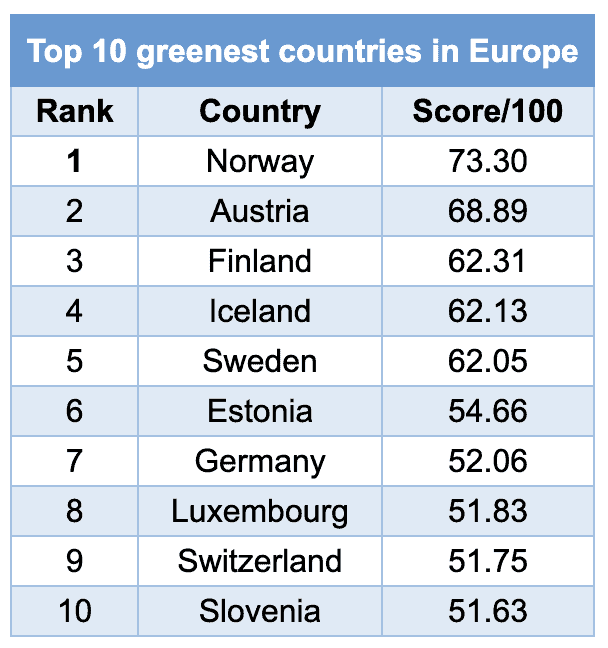
A new study by solar business Hemsol shows that Norway is the greenest country in Europe. It takes the crown thanks to its high renewable energy share recorded in 2022, despite having high carbon dioxide emissions per capita and large amounts of farmland area. Iceland has the highest rate of renewable energy share of all Europe which helped put the country in the fourth place overall.
The study used data from the European Environment Agency, the Odyssee-Mure Project and the Energy Institute to create an index with factors such as renewable energy share, recycling rates, and carbon dioxide emissions, to find out which European country can be considered the ‘greenest’ and most environmentally friendly.

Norway aims to reach net-zero carbon dioxide emissions between 2045 and 2055 while simultaneously reducing emissions of other greenhouse gases to near-net-zero in the same timeframe. The Norwegian government’s commitment to sustainability does not just stop at its own country; in fact, there is an international commitment to ensure that many developing countries can access clean and renewable energy through both bilateral and multilateral partners, as well as pledging up to 3 billion Norwegian Krone a year to help save the world’s tropical forests while improving the livelihoods of those who live off, in, and near them.
Austria is second
Second is Austria, which registered the highest share of passenger traffic on public transport in Europe, as its citizens are deciding to be more eco-friendly by not using their cars as much. Austria sees the second highest score in recycling rate but is sixth for carbon dioxide emissions.
Finland comes in third place. Its government recently enacted a new Climate Act, which establishes revised emission reduction objectives for 2030 and 2050. Specified targets include a reduction of 60% by 2030, 80% by 2040, and a goal of 90%, with an aspiration for 95%, by 2050, all measured against 1990 levels. As per the provisions of the new Act, Finland is mandated to achieve carbon neutrality by 2035.

Iceland is targeting carbon neutrality before 2040 and a 40% reduction in greenhouse gas emissions by 2030 in alignment with the Paris Agreement. To realise these objectives, Iceland relies on its primary policy tool, a Climate Action Plan updated in 2020, which outlines 48 specific actions to cut emissions and attain carbon neutrality.
The top five closes with Sweden, which has a high rate of woodland area and the second-best share of renewable energy use. Sweden has set the target to eliminate net greenhouse gas emissions into the atmosphere by no later than 2045. To attain this objective, a resolution stipulates that Sweden’s greenhouse gas emissions must register a minimum reduction of 85% by 2045 compared to the levels observed in 1990.
Northern Europe
William Bergmark, founder of Hemsol, commented on the findings: “It’s interesting to see how six of the countries in the top 10 are Northern European and how all Scandinavian countries figure in the top five. This is a testament to their commitment to the environmental cause more than anyone else in Europe, and this can be seen both in the data and in the practical regulations that they have put in place both at home and that they have pledged to help with internationally.”
The complete list:


